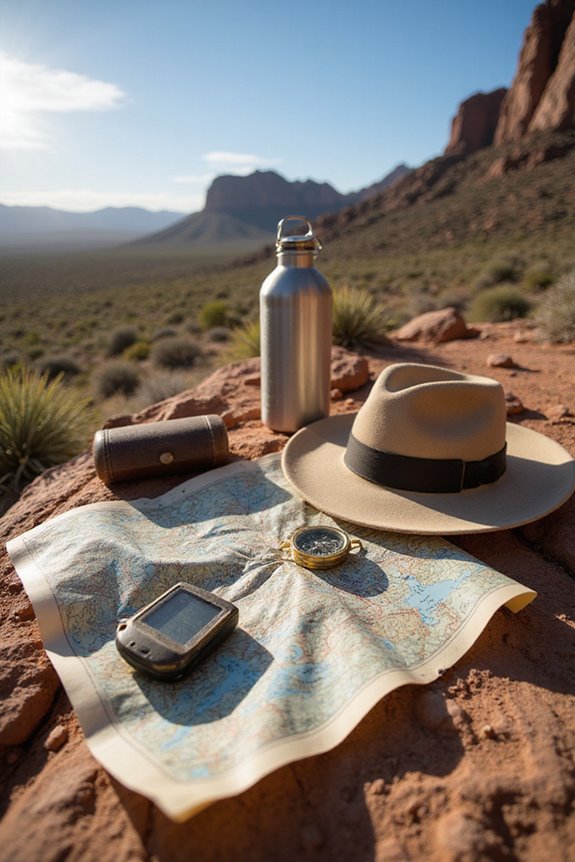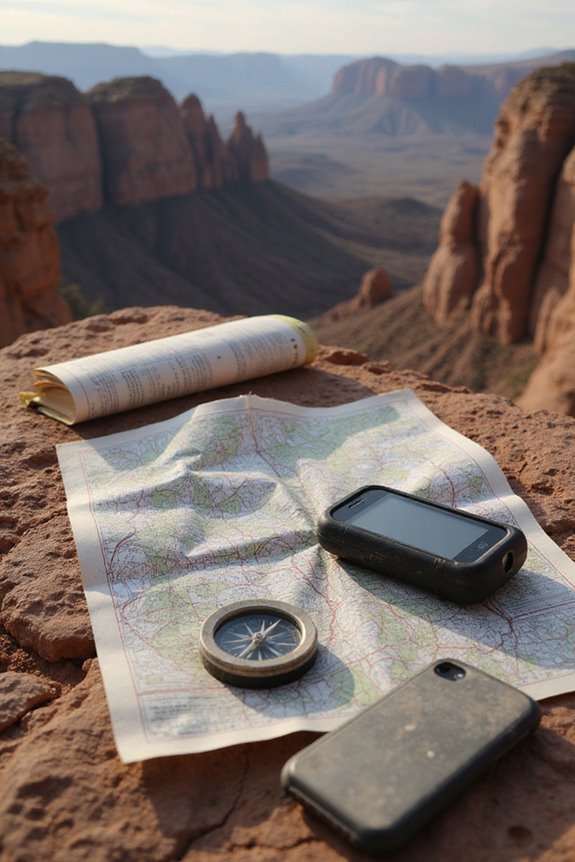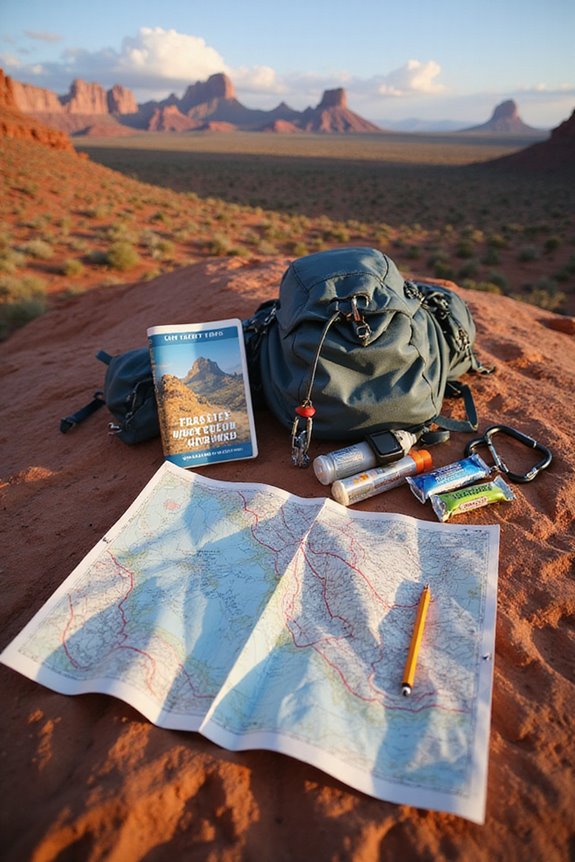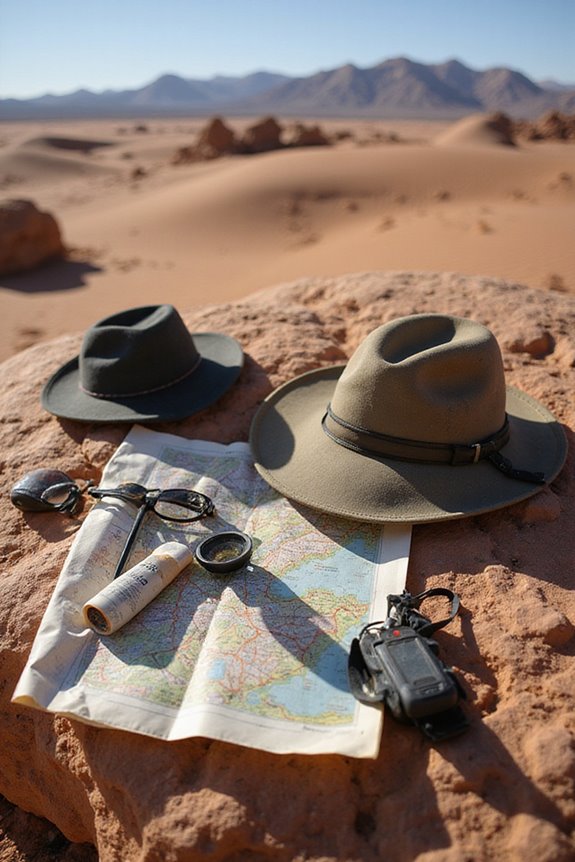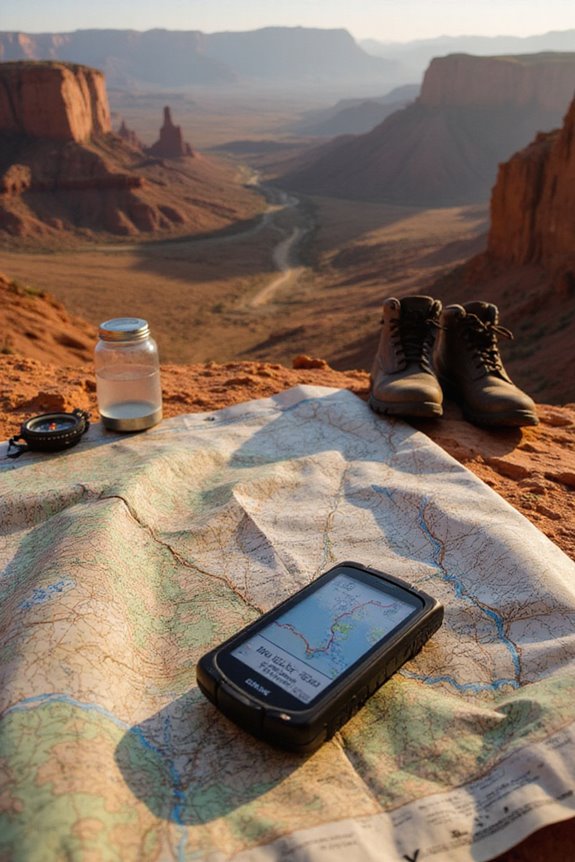When it comes to desert navigation, we need high-quality gear! First, let’s grab a reliable compass and a GPS device with a sunlight-readable display. Don’t forget a backup compass—trust me, it’s a lifesaver! We must stay hydrated with 7 to 10 liters of water daily and guarantee our clothing’s lightweight and UV-protective. Finally, carrying portable solar chargers helps keep our devices powered. Curious about even more desert essentials? Stick with us for further insights!
Key Takeaways
- Utilize a baseplate or lensatic compass for reliable navigation, ensuring maps align with magnetic north for accurate terrain assessment.
- Equip yourself with a portable solar charger and waterproof power bank to maintain device functionality without access to power sources.
- Mark key waypoints with brightly colored tape, reflective markers, or cairns, and utilize GPS apps for real-time tracking and breadcrumb navigation.
- Wear lightweight, light-colored clothing and a broad-brimmed hat with UPF 50+ rating for effective sun protection while navigating the desert.
- Carry a minimum of 7 to 10 liters of water daily, with a BPA-free hydration bladder to stay hydrated during your expedition.
Essential Navigation Tools
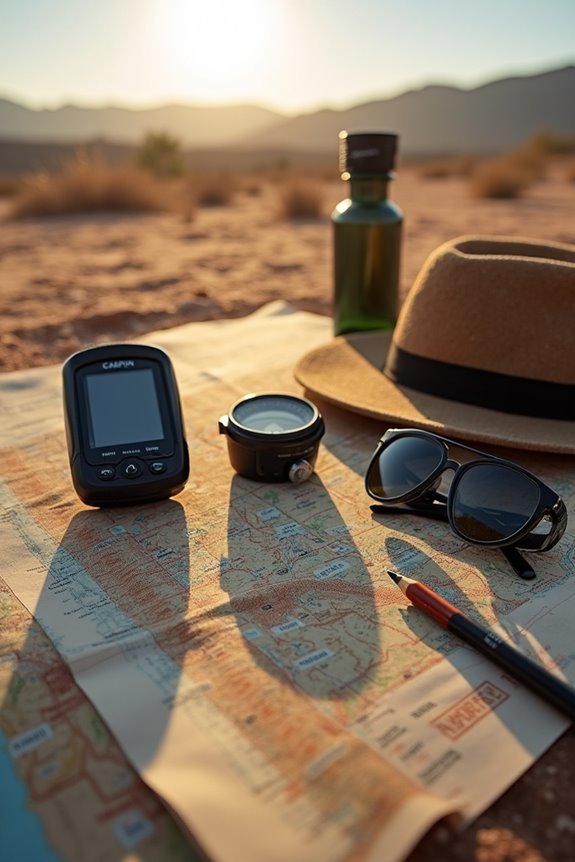
When it comes to traversing the vast and sometimes bewildering desert landscape, having the right tools is like packing your favorite snacks for a long hike—absolutely essential! We can’t emphasize enough the importance of compass types. From baseplate compasses for traditional navigation to lensatic ones for those in the military, each serves a purpose. And let’s not forget about map orientation! Aligning our maps with the magnetic north using our compass lets us visualize the terrain better. Plus, carrying a backup compass is like having an extra granola bar—just in case. Modern hiking GPS devices like the Garmin eTrex 32x offer sunlight-readable displays that remain visible even in the harsh desert sun. Together, these tools help us navigate the desert, plot our routes skillfully, and stay on the right track—because lost in the desert is exciting only in movies!
Power and Communication Gear
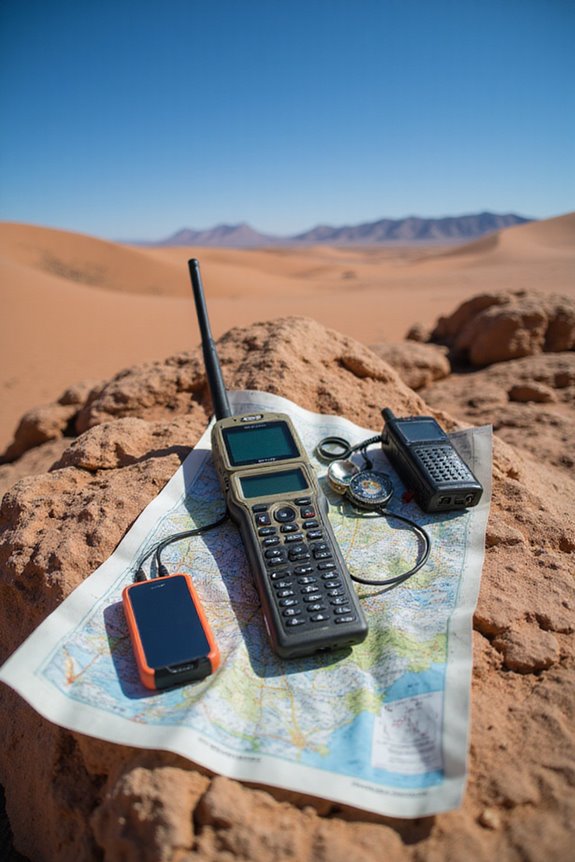
Ready to brave the desert’s endless expanse? Let’s gear up with the right power and communication tools! We need to focus on battery management—carrying extra batteries is a must, especially when heat and sand get involved. Portable solar chargers are game-changers, keeping us connected without relying on local power sources that might as well be a mirage! A waterproof power bank with IP67 rating or higher will protect your devices from sand and unexpected water exposure while offering reliable charging in harsh desert conditions.
For emergencies, satellite technology can be our lifeline. With devices that let us text, call, or send SOS alerts anywhere, we’ve got peace of mind even in remote stretches.
Marking and Route Tracing Equipment
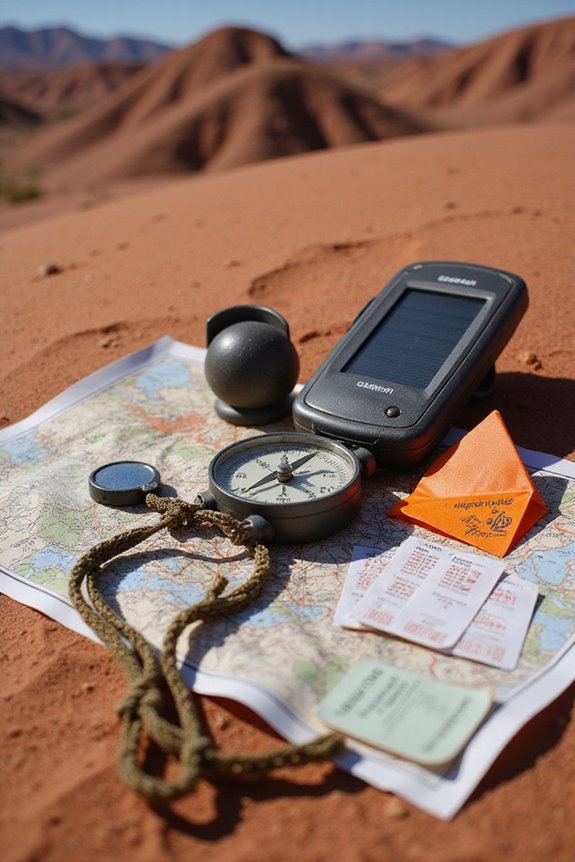
As we traverse the stunning, sun-scorched terrain of the desert, marking our route can turn a frustrating misadventure into an unforgettable journey. We’ve found that using physical markers like brightly colored flagging tape or reflective markers at key points is invaluable. Plus, placing cairns at significant waypoints keeps us confidently on track amidst vast sands.
For those into tech, digital mapping features in GPS apps offer amazing tools, like real-time tracking and breadcrumb navigation. Imagine effortlessly retracing your steps! We’ve enjoyed using biodegradable paint on rocks for temporary markers, too—talk about eco-friendly! With both tangible and digital solutions at our disposal, we can embrace the desert’s freedom while keeping our sense of direction—what’s not to love? Remember to pack a reliable water filter with 0.1 micron filtration capability to ensure safe hydration from any water sources you might encounter in the desert.
Protective Clothing and Eye Gear
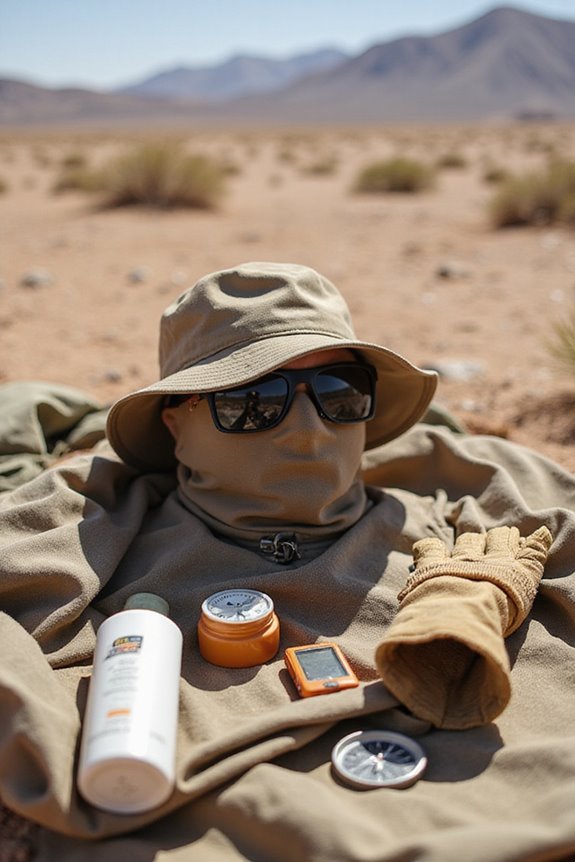
Protecting ourselves from the harsh desert elements isn’t just smart; it’s essential for a successful adventure. We need lightweight, breathable fabrics like nylon or moisture-wicking blends to keep us cool and comfortable. Goodbye, cotton—it just traps sweat and causes chafing! Opt for light-colored gear that reflects the sun’s rays, and don’t forget those long shirts and pants for solid sun protection.
A broad-brimmed hat shields our faces while a neck gaiter keeps our skin safe from burns. For maximum protection, look for hats with UPF 50+ rating which blocks 98% of harmful UV rays. And let’s talk eyewear—sunglasses with UV protection and wrap-around styles defend against glare and sand. Trust us; good eye gear makes all the difference when you’re traversing the sandy expanses, turning potential discomfort into the freedom of discovery!
Hydration and Health Supplies
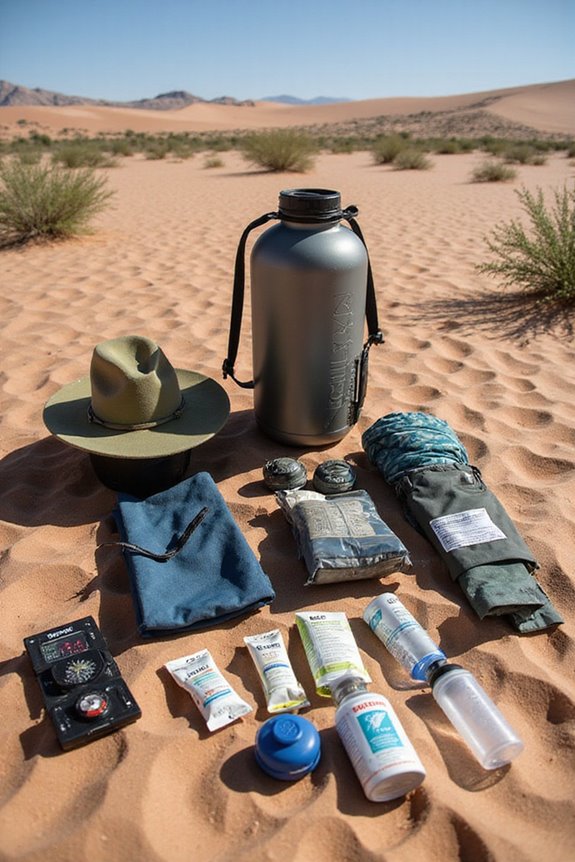
Hydration is the unsung hero of any desert adventure! We can’t underestimate the power of proper hydration strategies—carrying at least 7 to 10 liters per person daily is a must, especially in those sweltering conditions. A BPA-free hydration bladder? That’s our best friend, allowing hands-free sipping while we stay on the move!
And let’s not forget our health essentials. A well-stocked medical kit, complete with oral rehydration salts and sunscreen, is vital. Heat exhaustion is no joke! Frequent sipping keeps us balanced, and adding electrolyte supplements helps combat muscle cramps. Look for water bottles with leak-proof designs featuring secure lids and silicone gaskets to prevent water loss during your challenging desert expedition.
Frequently Asked Questions
What Should I Prioritize When Planning a Desert Navigation Trip?
When planning our desert navigation trip, let’s prioritize reliable navigation tools and identify local water sources. Like ancient explorers, we’ll need adaptability and courage to thrive in nature’s vast, unyielding expanse.
How Do I Cope With Extreme Temperature Fluctuations in the Desert?
To cope with temperature fluctuations, we must focus on effective temperature regulation and smart hydration strategies. Layering clothes properly and staying hydrated helps us enjoy the desert’s freedom while managing its extreme conditions comfortably.
Are There Specific First-Aid Supplies Needed for Desert Conditions?
When we hiked through the desert’s blazing sun, we learned the importance of hydration and sunburn prevention. Essential first-aid supplies, like electrolyte drinks and high-SPF sunscreen, turned a challenging trek into a safer, liberating adventure.
How Can I Ensure My Phone’s GPS Remains Functional in Remote Areas?
To keep our phone’s GPS functional in remote areas, we should prioritize battery management, use reliable GPS applications, and conserve power by turning off unnecessary features, ensuring we’ve got the freedom to explore without interruption.
What Types of Footwear Are Best for Navigating Sandy Terrain?
When exploring sandy terrain, we find hiking sandals and lightweight desert boots to be our best choices. These options keep our feet cool and comfortable, allowing us to enjoy every step of our adventure without restriction.

